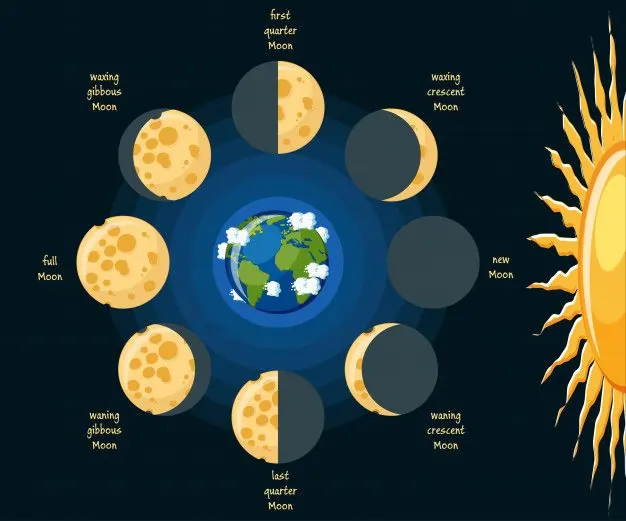The moon stands as one of the most prominent features of our night sky. For millennia, people have been fascinated by it, creating countless myths, legends, and scientific theories. One of the most captivating aspects of the moon is its lunar phases, which result from its movement around Earth. These phases change over about 29.5 days, creating a cycle that influences not only the moon’s appearance but also many aspects of life on Earth, such as tides, agriculture, and cultural practices.
In this article, we’ll explore lunar phases, how they occur, and their significance throughout history. We will also examine the science behind them, discuss the different phases, and look at their impact on the world.
What Are Lunar Phases?
The term “lunar phases” refers to the different stages the moon goes through as it orbits Earth. As the moon moves, the sunlight it reflects changes, causing the moon to shift in shape and size throughout the month. These phases follow a cyclical pattern, with each phase marking a specific point in the moon’s orbit.
The phases depend on the relative positions of Earth, the moon, and the sun. As the moon orbits Earth, sunlight illuminates different parts of the moon, creating the various phases we observe from Earth.
The Lunar Cycle
A full cycle of lunar phases lasts approximately 29.5 days, known as a “synodic month.” During this cycle, the moon passes through eight distinct phases, each representing a different stage of its orbit. These phases are:
- New Moon
- Waxing Crescent
- First Quarter
- Waxing Gibbous
- Full Moon
- Waning Gibbous
- Last Quarter
- Waning Crescent
As the moon completes its orbit, it moves from one phase to the next, creating a rhythmic cycle that has intrigued humans for centuries.
The Phases of the Moon
Each phase of the moon presents a unique visual appearance. The amount of light we see from Earth gradually increases or decreases as the moon progresses through its cycle.
1. New Moon
The New Moon marks the beginning of the lunar cycle. During this phase, the moon lies between Earth and the sun. The side of the moon illuminated by the sun faces away from Earth. As a result, the moon appears completely dark from our perspective. The New Moon phase is invisible to the naked eye.
This phase symbolizes new beginnings. Many cultures associate it with the start of projects, ventures, or cycles. People often use this time for reflection, rest, and setting intentions.
2. Waxing Crescent
After the New Moon, the moon begins to move away from the Earth-sun line. A sliver of light begins to appear along the moon’s right edge. This phase is called the Waxing Crescent. The light gradually increases, but the moon still appears as a thin crescent in the sky.
The Waxing Crescent phase represents growth, progress, and the early stages of development. It’s a time to take action and lay the foundation for the goals set during the New Moon phase.
3. First Quarter
The First Quarter phase occurs when the moon has completed about one-quarter of its orbit around Earth. Half of the moon’s surface becomes illuminated, and it appears as a half-moon in the sky.
The First Quarter phase signals a time of decision-making and evaluation. This phase offers an opportunity to assess progress and make adjustments. The energy of this phase calls for action and taking control.
4. Waxing Gibbous
In the Waxing Gibbous phase, the moon continues to move closer to being fully illuminated. The amount of light we see from the moon increases dramatically, and it begins to look more than half full.
This phase is characterized by momentum and anticipation. It’s a time for pushing forward, building on progress, and fine-tuning efforts before reaching completion. The Waxing Gibbous encourages perseverance and determination.
5. Full Moon
The Full Moon is the most iconic of the lunar phases. During this phase, the moon lies directly opposite the sun in the sky, with Earth in between. As a result, the entire face of the moon becomes fully illuminated, creating a bright, round shape in the night sky.
The Full Moon represents culmination and completion. It marks a time when things come to fruition. People often experience heightened emotions, revelations, or significant events. Many cultures celebrate this phase with gratitude, reflection, and acknowledgment of achievements.
6. Waning Gibbous
After the Full Moon, the light begins to decrease, and the moon enters the Waning Gibbous phase. The illuminated surface gradually diminishes, and the moon moves toward the Last Quarter phase.
The Waning Gibbous phase represents a time of release and gratitude. People reflect on what they’ve accomplished and let go of what no longer serves a purpose. This phase encourages introspection and completion.
7. Last Quarter
The Last Quarter phase is similar to the First Quarter in that half of the moon’s surface is illuminated. However, the light appears on the left side of the moon. This phase marks a time of closure and letting go.
The Last Quarter phase often corresponds to a period of rest and renewal. People assess what they’ve learned, clear obstacles, and prepare for the next cycle. Many use this phase to complete unfinished business and let go of unnecessary baggage.
8. Waning Crescent
The final phase of the lunar cycle is the Waning Crescent, which occurs just before the New Moon. During this phase, only a small sliver of the moon is visible, and the amount of light continues to decrease.
The Waning Crescent phase is a time for reflection, rest, and preparation. People finish loose ends and reflect on the entire lunar cycle before beginning again with the New Moon. This phase encourages quiet time, contemplation, and spiritual growth.
The Science Behind Lunar Phases
The lunar phases result from the changing positions of Earth, the moon, and the sun. The moon’s orbit around Earth is elliptical, meaning it doesn’t move in a perfect circle. As the moon orbits Earth, different parts of it become illuminated by the sun, creating the phases we observe.
It takes the moon about 27.3 days to complete one orbit around Earth. However, because Earth also moves around the sun, the moon needs about 29.5 days to return to the same position relative to the sun, completing one lunar cycle.
This cycle is driven by gravitational interactions between Earth and the moon. These interactions cause the moon to rotate on its axis at the same rate it orbits Earth. This phenomenon, known as synchronous rotation, means that the same side of the moon always faces Earth.
The Importance of Lunar Phases
Throughout history, lunar phases have played an important role in human culture and society. Many ancient civilizations tracked the moon’s cycle for practical reasons, such as determining the best times for planting crops, harvesting, and conducting religious ceremonies.
In modern times, lunar phases continue to influence our lives. For example, the Full Moon has long been associated with higher tides, called “spring tides,” which occur when the gravitational pull of the moon and sun align. Additionally, lunar phases can influence human behavior. Some people report feeling more energetic or emotional during certain phases, especially the Full Moon.
In many cultures, lunar calendars are still used to mark important holidays and events. For example, the Islamic calendar is based on lunar cycles, and the Jewish and Chinese calendars are also influenced by the phases of the moon.
Conclusion
The lunar phases offer a fascinating and essential glimpse into our natural world. From the New Moon to the Full Moon, these phases shape not only the moon’s appearance but also many aspects of our daily lives, from tides to cultural practices. Understanding the science behind the lunar cycle can deepen our connection to the moon and its influence on our planet.
Whether you’re gazing at the moon with wonder, tracking its phases for practical reasons, or using its cycle for spiritual reflection, the lunar phases offer a timeless rhythm that has captivated humanity for centuries. Read more science related articles on Public App.



